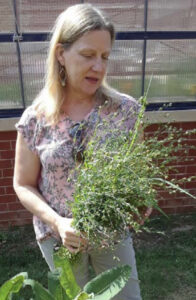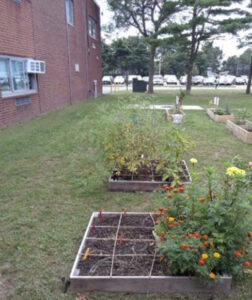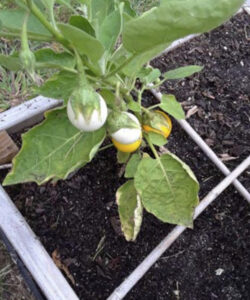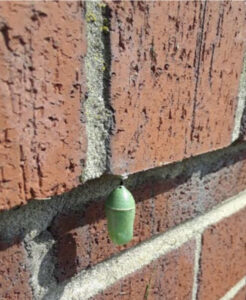“The SFGs are between two wings of the school. There is this wind vortex, and the wings block light in early morning and late afternoon. It might not be the greatest place to do it, but that was the space we had.

One of the history teachers who asked to grow flax is enjoying her harvest.
“We have always wanted to have multiple departments work together on the greenhouse, and adding the Square Foot Gardens gave us that opportunity. We didn’t have funding for the Mel’s MixTM, so our boss stepped up to the plate to help us get the materials, and another teacher donated piping and netting. The technology and woodworking department cut the wood and assembled the boxes. My research class mixed the Mel’s MixTM and installed the weed barrier. Then, the teachers decided what to plant at the end of the last quarter in the spring.
The Square Foot Gardening Foundation chatted with Janet Byler, Science teacher & Greenhouse Coordinator at Northport High School, to learn all about their Square Foot Gardening Program. Here’s what she said. “We had been planning for the greenhouse for years but thought maybe we’d do something outside. After a local news article featured us pouring the greenhouse foundation in November 2018, Laura Bartholomew saw the article, and contacted me.
“She came to our school and did a presentation with the teachers who had an interest in the greenhouse, going over the technique and providing us with the Square Foot Gardening books (which tell you everything you need to know, even the size boards to use).

Several Square Foot beds were planted. A generous number of marigolds were planted as well as edibles.
“When she described the SFG technique, I thought, I can do this (although I had never had a vegetable garden in my life). I’m not afraid to try it. Let’s do it!
“I met with other teachers and the high school custodial/groundskeeping people to come up with locations that would be appropriate. Because we did ask before doing everything, the groundskeepers felt like they were a part of it. We spaced the boxes so that the weed whackers could get in between, and when they mow, it looks beautiful.
“When school came to an end and the greenhouse and SFGs were growing, we thought, What are we doing over the summer when everyone is gone? Eight teachers agreed to water the gardens and greenhouse. Everybody took a week. If anything ripened while you were “on duty,” it was yours! This year, in September, we’re getting beautiful marigolds and zinnias from seed; we did not plant enough zinnias. Eggplant did very well, tomatoes did great, as did peppers. Now, we have this beautiful garden, and it draws people to look at the gardens on their way out of school. We had praying mantses for the first time recently. Now, we’re planning for the winter: which ones [squares] will sleep and which ones will be winter vegetables and leafy greens. We’d like to get some teachers or the gardening club to plan for next year so that the students can decide this time. The boxes make all the difference; they’re excellent for schools and easy for schools to maintain.
“What I’ve realized is that you have to be willing to try and realize you might fail. Laura was so encouraging, and that gave me the courage to try. If you read the book, you pretty much can’t fail. Everything is going to grow, even if it might not grow the way you expected. Now, I would love the history department to get involved and plant heirloom seeds or medieval garden herbs. Wouldn’t that be fun?”



